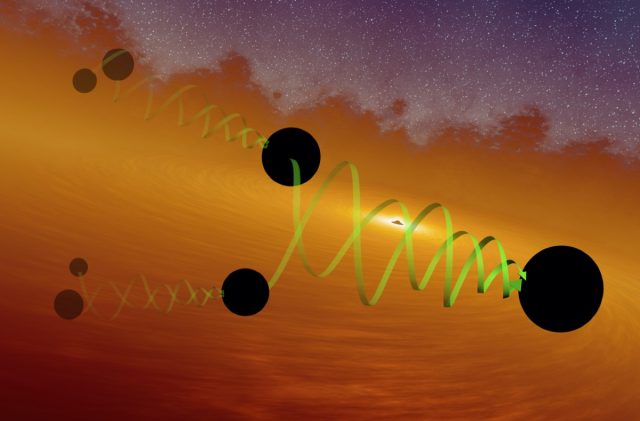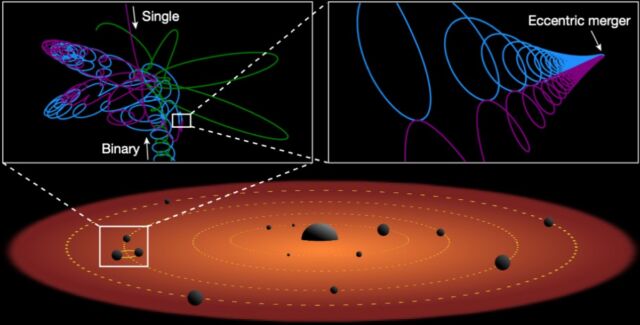
In 2019, the LIGO/VIRGO collaboration picked up a gravitational wave signal from a black hole merger that proved to be one for the record books. Dubbed "GW190521," it was the most massive and most distant yet detected, and it produced the most energetic signal detected thus far, showing up in the data as more of a "bang" than the usual "chirp."
Furthermore, the new black hole resulting from the merger was about 150 times as heavy as our Sun, making GW190521 the first direct observation of an intermediate-mass black hole. Even weirder, the two black holes that merged were locked in an elliptical (rather than circular) orbit, and their axes of spin were tipped far more than usual compared to those orbits.
Physicists love nothing more than to be presented with an intriguing puzzle that doesn't immediately seem to fit established theory, and GW190521 gave them just that. New theoretical simulations suggest that all those bizarre aspects can be explained by the presence of a third single black hole horning in on the binary system's final dance to produce a "chaotic tango," according to a new paper published in the journal Nature.
As we reported previously, on May 21, 2019, the collaboration's detectors picked up the telltale signal of a binary black hole merger: four short wiggles lasting less than one-tenth of a second. The shorter the signal, the more massive the black holes that are merging—in this case, 85 and 66 solar masses, respectively. The black holes merged to form a new, even larger black hole of about 142 solar masses, emitting the energetic equivalent of eight solar masses in the process—hence, the powerful signal picked up by the detectors.
What made this event so unusual is that the measurement of 142 solar masses falls smack in the middle of what's known as a "mass gap" for black holes. Most such objects fall into two groups: stellar-mass black holes (ranging from a few solar masses to tens of solar masses) and supermassive black holes, like the one in the middle of our Milky Way galaxy (ranging from hundreds of thousands to billions of solar masses). The former are the result of massive stars dying in a core-collapse supernova, while the latter's formation process remains something of a mystery.

The fact that one of the progenitor black holes weighs in at 85 solar masses is also highly unusual since this is at odds with current models of stellar evolution. The kinds of stars that would give rise to black holes between 65 and 135 solar masses would not go supernova and thus would not end up as black holes. Rather, such stars would become unstable and slough off a significant chunk of their mass. Only then would they go supernova—but the result would be a black hole of less than 65 solar masses.
The most favored explanation among physicists at the time was that GW190521 was an example of a so-called "hierarchical merger," meaning the two progenitor black holes were themselves the result of a previous merger before they found each other and merged. That scenario implies sufficient other black holes nearby to enable multiple mergers.
But the evidence was not conclusive, and physicists hoped to get additional clues from corresponding electromagnetic data; the Zwicky Transient Facility (ZTF) detected a flare emerging 35 days after the gravitational-wave signal from the same region of the sky. This was also unusual, as a black hole merger typically doesn't emit light.
One possible explanation is that the merger did not occur in empty space. A supermassive black hole at the center of a galaxy will often be surrounded by an enormous, flat rotating gas disk. Smaller black holes can fall into that disk, feeding off the matter in the disk to grow larger. Over time, those smaller black holes move closer together, forming binary systems that eventually merge. That's consistent with the proposed hierarchical merger scenario; having so many black holes in an enormous flat, gassy disk vastly increases the likelihood of a collision that creates a larger black hole.

It also explains a couple of other unusual aspects of this merger. The gravitational wave data indicated that the two black holes were locked in a highly elongated elliptical orbit, which wouldn't happen in an isolated environment. However, if these two black holes fell into orbit within a disk, the material would suck up some of the energy from their motion. And should a third black hole outside the binary system get a bit too close, its gravity could give an extra "kick" to the system, shifting their orbits from circular to elliptical. It's essentially the classic three-body problem, although co-author Hiromichi Tagawa of Tohoku University whimsically described it as "a chaotic tango with three black holes flying around."
The simulations showed that, in such a scenario, the odds of black hole mergers with eccentric orbits rises by a factor of 100. "In these environments, the typical velocity and density of black holes is so high that smaller black holes bounce around as in a giant game of billiards, and wide circular binaries cannot exist," said co-author Bence Kocsis of the University of Oxford.
And as Phil Plait (aka the Bad Astronomer) explained over at Syfy Wire, this scenario would also account for the unusual spin axes of the two binary black holes prior to merging. Normally, their axes of spin will point in the same direction, about 90 degrees from their orbital plane. The two black holes in GW190521 had spin axes much higher than that. The authors suggest that a third single black hole's gravity would also pull powerfully enough on the pair to keep them spinning in the same direction while tipping the axis.
While the simulations provide a fascinating explanation, it's still not conclusive. “People have been working on understanding the structure of such gas disks for many years, but the problem is difficult," said co-author Zoltan Haiman of Columbia University. "Our results are sensitive to how flat the disk is and how the black holes move around in it. Time will tell whether we will learn more about these disks once we have a larger population of black hole mergers, including more unusual cases similar to GW190521."
DOI: Nature, 2022. 10.1038/s41586-021-04333-1 (About DOIs).
Science - Latest - Google News
March 15, 2022 at 12:54AM
https://ift.tt/oG5YwTJ
Black hole “billiards” may explain strange aspects of 2019 black hole merger - Ars Technica
Science - Latest - Google News
https://ift.tt/HuhxLzC
https://ift.tt/rNfxH1J
Bagikan Berita Ini

















0 Response to "Black hole “billiards” may explain strange aspects of 2019 black hole merger - Ars Technica"
Post a Comment